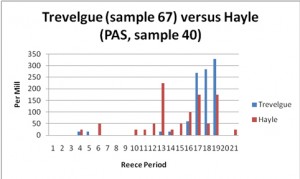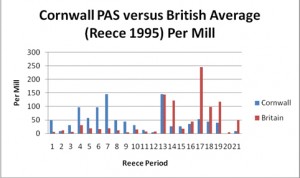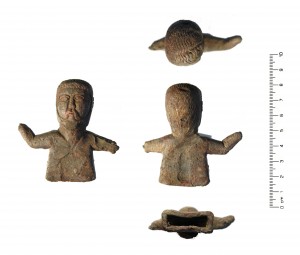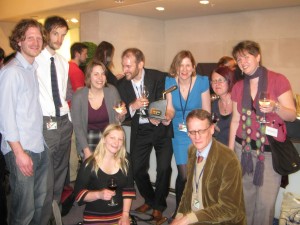Total posts:
187
03/15/2011
The nature of the Roman occupation of Cornwall remains elusive, largely due to the scarcity of sites and finds. However, the PAS has played a significant role in the discovery of several new sites, including the fort at Restormel. The steadily growing number of site-finds of Roman coins (now standing at 294) is a highly important dataset. Amongst these coins is a large assemblage from the Hayle area which highlights the importance of this region in the late Roman period. The graph below shows the chronological distribution of coins from before AD 41 (Period 1) to AD 388-402 (Period 21). Hayle is shown against the only other comparable site from the whole of Cornwall, Trevelgue.

Furthermore, the PAS coins overall provide a higher proportion of late Roman coins than is shown by past coin hoards. The PAS data was instrumental for a recent MA dissertation on Roman Cornwall written at Leicester University. It is also important to note that important new Roman discoveries are being recorded with the PAS in Devon and that the work in both counties combined will help to produce a new understanding of the South-West Peninsula as a whole in the coming years.
The graph below shows how the coin profile over time for Cornwall is very different from the national average for Britain. The time periods range from pre-AD 41 (Period 1) to AD 388- 402 (Period 21).

Finally, Cornwall has produced a number of Late Roman and Byzantine coins from the Eastern Mediterranean. This does suggest sea trade coming out of the Straits of Gibraltar and across the Bay of Biscay to Cornwall. What is really interesting is that such coins are also being found on the Isle of Wight – in fact, the PAS is showing that Cornwall and the Isle of Wight share much more in common than we previously thought.

02/28/2011

Every year the PAS team in the West Midlands are asked to contribute to West Midlands Archaeology, a journal that tries to capture all the archaeological work carried out within the year (see http://www.britarch.ac.uk/cbawm/WMA.php). We as a group try and identify objects that are both locally and regionally imporant finds; however we also like to highlight particularly good examples of more common or specific types of find.
The volume that covers 2009 (WMA 52) is currently being edited for publictaion. And we are now starting to think about those finds for 2010.
As some of you may know from reading my reports I have a tendency for writing considerable amounts and therefore this year the editor has published summaries of some the PAS finds in the journal but also published the full text on the CBA West Midlands website
http://www.britarch.ac.uk/cbawm/PAS_finds.php
Rather than copying and pasting these finds on here – I thought I would direct people to have a look at the article over there – all the finds highlighted are really rather impressive and also important. In addition I would also like to thank the finders who made these artefacts available for recording especially as I had to borrow them for longer than usual to have them illustrated
The full PAS records for each find can be found below
https://finds.org.uk/database/artefacts/record/id/257919
https://finds.org.uk/database/artefacts/record/id/255545
https://finds.org.uk/database/artefacts/record/id/263894
https://finds.org.uk/database/artefacts/record/id/264493
https://finds.org.uk/database/artefacts/record/id/255227
https://finds.org.uk/database/artefacts/record/id/267930
Peter Reavill
FLO Shropshire and Herefordshire
02/26/2011
February 26th, 2011 by Ian Richardson
This weekend, for the third year out of the last four, the British Museum plays host to the annual Current Archaeology Conference. The conference is well-known for the breadth of topics covered and the diverse array of talented speakers taking part simultaneously across two lecture theatres. It also bestows its own unique set of reader-chosen awards, and the Portable Antiquities Scheme (PAS) featured heavily in those given out this year.
Saturday’s papers featured several appearances by members of the PAS, the co-hosting organisation. Rob Collins, Finds Liaison Officer for the North East region, served as co-chair for the popular morning session on Hadrian’s Wall. Roger Bland, Head of the Portable Antiquities Scheme, chaired the specialist afternoon session on recent finds of Treasure, which saw talks given by the PAS’s Sam Moorhead (on the Frome Hoard), Ian Richardson (on the Hackney Double Eagle coins) and Laura McLean and Stephanie White (on the Burnham on Crouch Bronze Age Hoard). The British Museum’s Nick Ashton (Dept. of P&E) also delivered a fantastic account of the current work on the evidence for Britain’s oldest humans at Happisburgh, Norfolk, and Ian Leins (Dept. of C&M) anchored a prominent session on Britain’s Iron Age Celts.
Throughout the day, the tireless work of conference facilitator Philippa Walton kept things running smoothly and on time. In the large foyer of the British Museum’s Clore centre, amongst the collection of book and package-tour retailers, and the various other heritage advocacy groups, Wendy Scott, Adam Daubney, Stephanie Smith, Ros Tyrell, Danielle Wootton and Erica Darch manned the PAS desk and handed out numerous flyers and copies of annual reports to interested visitors.
The highlight of this first day’s events was the handing out of the Current Archaeology awards for the most outstanding work of the last year. The PAS made out fantastically well against stiff competition, with Sam Moorhead taking home the gilded trowel for Archaeologist of the Year for his work as a National Finds Advisor on Roman Coinage and in particular for his involvement in work on the Frome Hoard and for his publication of the popular ‘AD410: The Year that Shook Rome’. Sam’s acceptance speech attempted to deflect attention away from himself and he claimed his role with the PAS automatically exposed him to the type of popular interest stories that most archaeologists would not have the privilege of working on, but those voting had already taken that into account when making their decision. Sam also graciously led everyone in a toast to our recently departed colleague, the irreplaceable medieavalist Geoff Egan. The Excavation of the Frome Hoard received an award itself, for ‘Rescue Excavation of the Year’ and Sam Moorhead accepted that trophy on behalf of colleagues Anna Booth, Katie Hinds. Steve Minnit and the finder of the hoard, Dave Crisp.
Taking advantage of a unique opportunity to capture several hundred archaeologists together in one space on a Saturday evening, the organisers of the Current Archaeology conference treated all those present to a once-in-a-decade appearance by the (in)famous rock band ‘Timothy Darvill and the Standing Stones’. Displaying a surprising range of musical knowledge, the group (led by early morning presenter and lead guitarist Professor Timonthy Darvill of Bournemouth University) crooned away to songs from some of the industry’s best-known talents, from Elvis Prestly to CCR, the Beatles to the Rolling Stones, Blondie to the Kaiser Chiefs. What better way to end the evening than to pogo along with fan Julian Richards to ‘I Predict a Riot’? (Yes, we are geeks…)

01/07/2011
The Centre for Audio-Visual studies and practice in Archaeology is holding an inaugural series of seminars at the Institute of Archaeology, UCL, 31- 34 Gordon Square on Monday afternoons, starting this coming week. The programme is quite varies and the following speakers are booked to speak:
10 Jan Broadcast archaeology Michael Wood (Story of England, BBC) & Ray Sutcliffe (Chronicle)
17 Jan Producing archaeology on TV Charles Furneaux (Kaboom Film and Television)
24 Jan Archaeology and radio Ben Roberts (The British Museum)
31 Jan Using digital technology to visualise the past Tom Goskar (Wessex Archaeology) and Stuart Eve (UCL)
7 Feb The Google ancient places prokect Leif Isaksen (University of Southampton)
21 Feb Archaeology, television and the public Tim Schadla-Hall & Chiara Bonacchi (UCL)
28 Feb Developing digital communities Andy Bevan and Lorna Richardson (UCL)
7 Mar The Portable Antiquities Scheme Dan Pett (The British Museum)
14 Mar Archaeology, videogames and the public Andrew Gardner (UCL)
21 Mar Where do we go from here Don Henson (Honorary Director of CASPAR)
Enquiries to: Tim Schadla-Hall t.schadla-hall@ucl.ac.uk or Chiara Bonacchi chiara.bonacchi@gmail.
All seminars in room 612 and everyone is welcome. A drinks reception follows each seminar.
01/06/2011
King’s Head Strap Clasps or Buckles
It can be quite impressive how one find can spark a level of interest in a type that previously seemed relatively dull and ordinary.
A couple of months ago, I was pleasantly surprised to have a small face staring back at me from within that batch of finds received to be recorded. That face, with two beady eyes, a slit mouth and spiky hair was recorded as WAW-2C1F52, a cast copper alloy two part folding strap clasp, dated to the 14th Century.

From the published literature, (Egan and Pritchard, 2002, Dress Accessories, #568) and Meols, #721, this particular type of strap clasp would seem relatively scarce. However several searches on the PAS database turned up over 100 examples. So perhaps they are not as rare as the published literature would lead us to believe.
The examples from the PAS database appear to fall into 6 main decorative types:
A Crowned Head (which lead to their nickname as “King’s Head Buckles”);
Url: https://finds.org.uk/database/artefacts/record/id/227703 PAS record number: ESS-6E39D5
Object type: Clasp
Broadperiod: Medieval
County of discovery: Essex
Stable url: https://finds.org.uk/database/artefacts/record/id/227703
A Mitred Head (imitating a bishop as opposed to a King);

Medium sized image of: BERK-CEEEB7 a MEDIEVAL Clasp
BERK-CEEEB7
a Plain head;

Medium sized image of: WAW-2C1F52 a MEDIEVAL CLASP
WAW-2C1F52
a Head and Shoulders type;

Medium sized image of: DENO-1CFB90 a MEDIEVAL buckle
DENO-1CFB90
a Zoomorphic or Animal head variant

Medium sized image of: NCL-730447 a MEDIEVAL BUCKLE
NCL-730447
and a Geometric designed type.

Medium sized image of: NMS-E21D84 a MEDIEVAL strap fitting
NMS-E21D84
The majority of these examples exist just as the frame of the clasp, or as partial remains of the frame, but some still retain the strap plate. Some even have a pin present, suggesting that they operated as a buckle as opposed to a clasp. The difference between a buckle and a clasp in this situation is the presence or absence of a pin, which means in the absence of a strap plate, or evidence on the frame, then it is hard, if not impossible to determine if a particular example operated as a clasp or a buckle. However it is worth noting that the frame seemed to function for both purposes. It is still unknown exactly how this type operates as a two part folding strap clasp. Further research, including examination of iconographic sources (e.g. paintings and memorial brasses) will have to be done.
They appear to be mainly central and south east in geographical distribution, with Lincolnshire and Norfolk having significantly more examples than other counties.
More work needs to be done to locate more stratified examples, to confirm that the dating is 14th Century. The unstratified material from the PAS database would suggest that there should be significantly more examples out there than the excavated examples suggest, just that no one has really considered them important enough to examine.
Therefore, if anyone comes across any further examples, I would be very interested to hear about them.
My email address is teresa.gilmore@shropshire.gov.uk.
01/05/2011

Every year the PAS team in the West Midlands are asked to contribute to West Midlands Archaeology, a journal that tries to capture all the archaeological work carried out within the year (see http://www.britarch.ac.uk/cbawm/WMA.php). We as a group try and identify objects that are both locally and regionally imporant finds; however we also like to highlight particularly good examples of more common or specific types of find.
The volume that covers 2009 (WMA 52) is currently being edited for publictaion. And we are now starting to think about those finds for 2010.
As some of you may know from reading my reports I have a tendency for writing considerable amounts and therefore this year the editor has published summaries of some the PAS finds in the journal but also published the full text on the CBA West Midlands website
http://www.britarch.ac.uk/cbawm/PAS_finds.php
Rather than copying and pasting these finds on here – I thought I would direct people to have a look at the article over there – all the finds highlighted are really rather impressive and also important. In addition I would also like to thank the finders who made these artefacts available for recording especially as I had to borrow them for longer than usual to have them illustrated
The full PAS records for each find can be found below
https://finds.org.uk/database/artefacts/record/id/257919
https://finds.org.uk/database/artefacts/record/id/255545
https://finds.org.uk/database/artefacts/record/id/263894
https://finds.org.uk/database/artefacts/record/id/264493
https://finds.org.uk/database/artefacts/record/id/255227
https://finds.org.uk/database/artefacts/record/id/267930
Peter Reavill
FLO Shropshire and Herefordshire
OxriANWHbvZh









